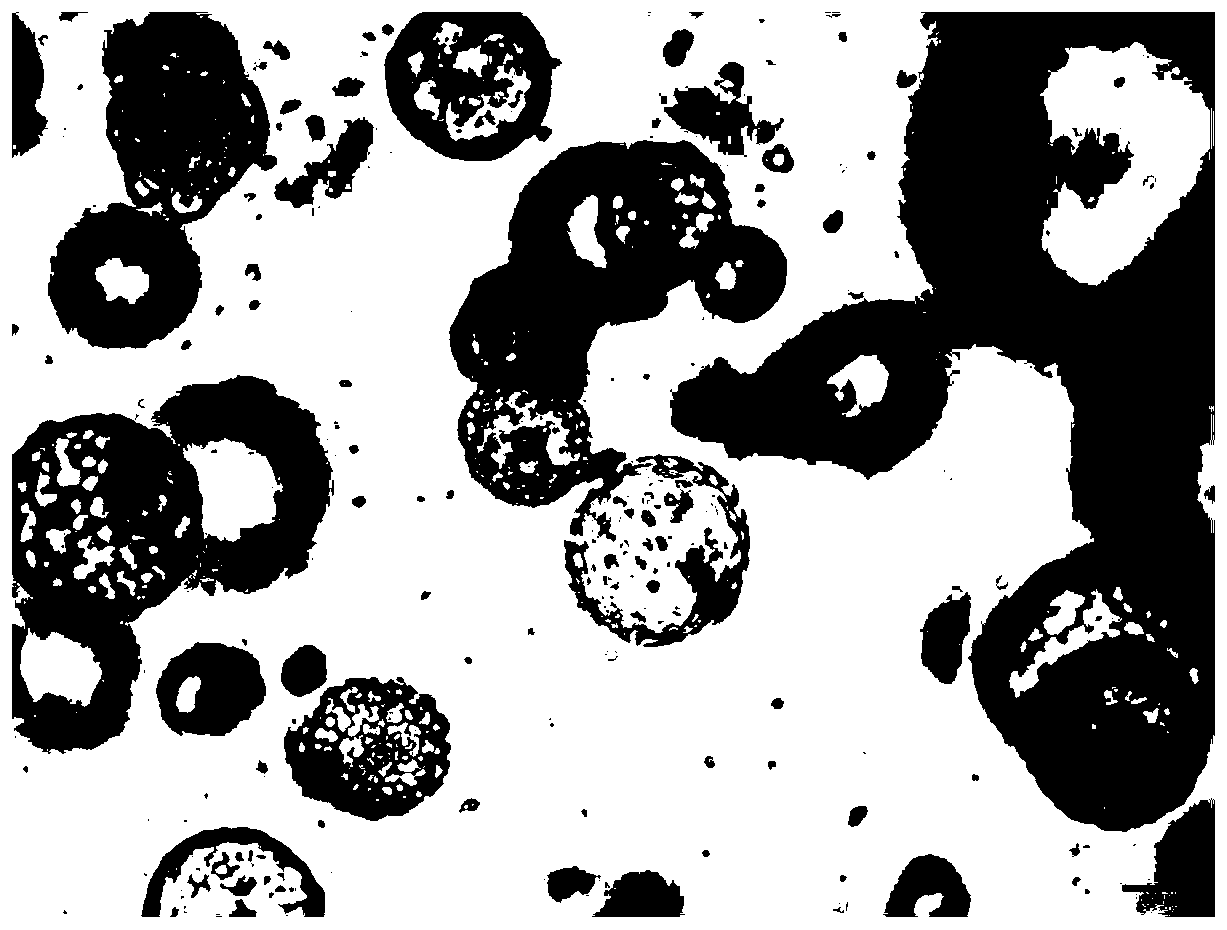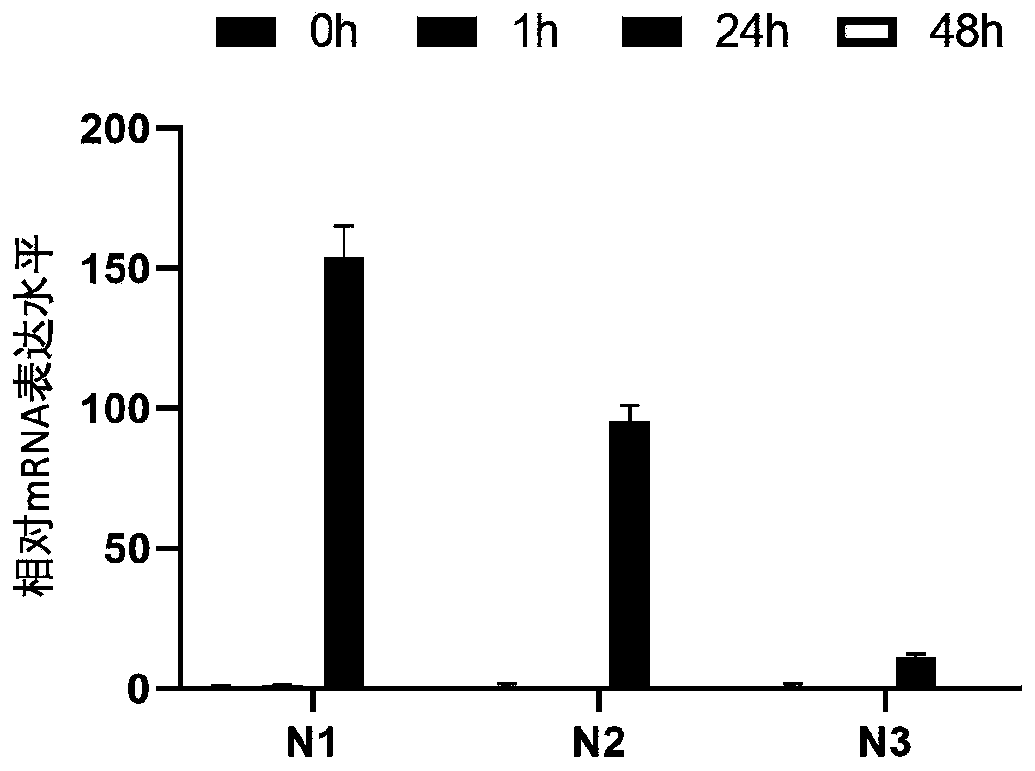Construction method and application of organoid virus infection model
A construction method and virus infection technology, applied in the fields of biomedicine and cell engineering, can solve the problems of long cycle, unfavorable management, pathogenic microorganism contamination, etc.
- Summary
- Abstract
- Description
- Claims
- Application Information
AI Technical Summary
Problems solved by technology
Method used
Image
Examples
Embodiment 1
[0109] Example 1: Isolation and culture of human lung organoids
[0110] 1. Take the lung tissue resected by lung surgery and place it in the pre-cooled basal medium at 4°C. The basal medium components are: Advanced DMEM / F12 medium, penicillin, GlutaMax and HEPES to maintain the tissue cells. active.
[0111] 2. Cut the lung tissue obtained in step 1 into 0.5mm with surgical scissors 3 and transferred to a 15mL centrifuge tube, adding 10mL of washing medium (composition: DMEM medium, 1% fetal bovine serum, 1% penicillin) and repeatedly pipetting to obtain small pieces of lung tissue.
[0112] 3. Let the small pieces of lung tissue obtained in step 2 settle down, and remove the supernatant. Then add 10 mL of washing medium, mix by pipetting, and obtain small pieces of lung tissue.
[0113] 4. Remove the excess washing medium as much as possible from the small pieces of lung tissue obtained in step 3, and add 37°C preheated digestion medium, the composition of which is isolat...
Embodiment 2
[0132] Example 2: Isolation and culture of human liver organoids
[0133] 1. Take the liver tissue resected by liver surgery and place it in the pre-cooled basal medium at 4°C. The basal medium components are: Advanced DMEM / F12 medium, penicillin, GlutaMax and HEPES to maintain the tissue cells. active. , to obtain small pieces of liver tissue
[0134] 2. Cut the liver tissue obtained in step 1 into 0.5mm with surgical scissors 3 and transferred to a 15mL centrifuge tube, adding 10mL washing medium (composition: DMEM medium, 1% fetal bovine serum, 1% penicillin) and blowing repeatedly.
[0135] 3. Let the small pieces of lung tissue obtained in step 2 settle down, and remove the supernatant. Then add 10 mL of washing medium, mix by pipetting, and obtain small pieces of liver tissue.
[0136] 4. Remove as much excess washing medium as possible from the small pieces of lung tissue obtained in step 3, and add 37°C preheated digestion medium, the composition of which is collag...
Embodiment 3
[0152] Example 3: Isolation and culture of human intestinal organoids
[0153] 1. Take the intestinal tissue resected by intestinal surgery and place it in the pre-cooled basal medium at 4°C. The basal medium components are: Advanced DMEM / F12 medium, penicillin, GlutaMax and HEPES to maintain the tissue cell activity.
[0154] 2. Use a scalpel to gently scrape off the fluff on the inner wall of the intestinal tissue obtained in step 1, and then use surgical scissors to cut it into 0.5cm 3 and transfer it to a 15mL centrifuge tube, add 10mL PBS, and pipette repeatedly to obtain small pieces of intestinal tissue.
[0155] 3. Set aside the small pieces of intestinal tissue obtained in step 2 to settle, and remove the supernatant. Add 10 mL of PBS solution containing 5 mM EDTA and let stand at 4° C. for 25 minutes for digestion.
[0156] 4. Transfer the intestinal tissue digested in step 3 to a new Petri dish containing 10 mL of PBS, repeatedly pipet the intestinal tissue about...
PUM
 Login to View More
Login to View More Abstract
Description
Claims
Application Information
 Login to View More
Login to View More - R&D
- Intellectual Property
- Life Sciences
- Materials
- Tech Scout
- Unparalleled Data Quality
- Higher Quality Content
- 60% Fewer Hallucinations
Browse by: Latest US Patents, China's latest patents, Technical Efficacy Thesaurus, Application Domain, Technology Topic, Popular Technical Reports.
© 2025 PatSnap. All rights reserved.Legal|Privacy policy|Modern Slavery Act Transparency Statement|Sitemap|About US| Contact US: help@patsnap.com



